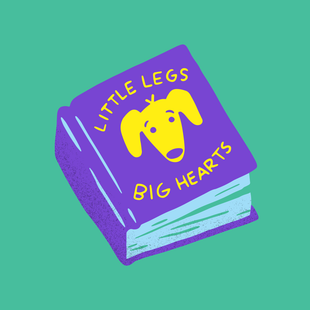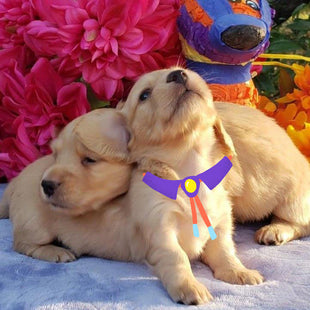
The term socialization inspires images of large puppy play groups, but the key developmental process includes a whole lot more than just other dogs, or even other people. Proper socialization allows your new dachshund to approach people, pups, and new situations with confidence and ease and helps prevent aggressive or anxious behavior as your doxie grows.
The earlier you can start socializing your pup the better, since they’re more open to new situations when they’re younger, so focusing on socialization activities when your dachshund is between 8 and 12 weeks old is ideal. You may be thinking, but what about their shots?! Don’t worry — you can start socializing your dachshund from the safety of your own home, and then introduce them to other pups once they’ve received all their necessary shots.
While socializing your dachshund won’t eliminate their (lovable) stubbornness, you’re more likely to strike a balance between independence and fierce loyalty. So before you parade your new pup around the dog park, here are some great ways to socialize your dachshund.
Explore new surfaces
Photo via @twodoxiebros
Grass, concrete, wood, and carpet are all totally normal surfaces to us humans, but for a pup, these feel dramatically different on their paws. Take it one surface at a time, preferably with a leash on to reaffirm that you’re in control of the situation, and encourage your dachshund as they take their first steps in each new setting. Not only will you be better preparing them to go for walks in a variety of different environments, but you’ll also be building their trust as they rely on your confidence in new situations. Once you’ve covered the basic surfaces, you can also introduce household objects like cookie sheets or rubber bath mats to continue to build your dachshund’s comfort and confidence.
Invade their space
Photo via @minicooperdoxie
Just like children, it’s important that your dachshund pup learn to share. Getting them comfortable with you touching their toys or food will help prevent possessiveness and aggression down the line when more humans or dogs are around, which makes them far more fun to spend time with. Try taking their toy away too and replace it with another toy, rewarding them when they don’t growl. This will help them not only play nicer with other pups, but also comes in handy for when small children are around and take interest in a stuffed animal that your doxie happens to love. Another idea? While they’re eating, get on their level and pet them gently, to teach that they don’t need to get territorial around their food.
Introduce new sounds
Photo via @minicooperdoxie
It’s easy to forget how many different sounds we’re exposed to everyday! Getting your dachshund comfortable with all sorts of noises, both in and outside of the house, makes it easier for them to navigate their world with confidence. You can start by leaving the radio on, or closing and opening doors with a bit more vigor. Follow up with reassurance or a treat to affirm that these noises are nothing to be afraid of. Ready for louder noises? The vacuum cleaner is a good level up. Start at a safe distance where your pup can see you and the vacuum cleaner, and avoid getting too close — that machine can be scary! Your calm, encouraging nature is key when introducing new noises so your dachshund knows they can trust you to judge whether or not they’re safe.
Change up your walking route
Photo via @itspennypaloma
What better way to get exposure to new sights, smells, and sounds than by exploring different parts of your city or neighborhood? The first step, though, is getting your pup comfortable on leash. Praise them when you clip on their leash and harness — harnesses are preferable to collars for doxies, since they can protect from strain on their neck and back — and let them take their time moving around. You can do this inside the house before heading out into the world, too! Once they’re more confident with their new gear, head to spots where there are more people buzzing around. It’s ok if they don’t want to stop and say hello to every person walking by, but the exposure to new settings with you by their side helps solidify you as a source of safety.
Get on their level
Photo via @tequenoquemado
As you introduce new humans to your dachshund, a few guidelines can go a long way to avoid provoking fear. Ask friends to kneel or crouch down to the ground — they’re less of a giant this way — and patiently wait for your doxie to approach them. Your presence will help reassure them, and they’ll benefit from hearing your praise once they approach the new human and let themselves be pet. And though you may be inclined to hold your doxie while introducing them to your friends, letting them stand on their own gives them more of a sense of control. If you’re bringing little ones around your dachshund pup, it may be wise to ensure their parent is there and that they know to be gentle with your doxie. Petting their body is preferable to petting their head for starters too, as it feels less threatening.
Ease your way in to new puppy friends
Photo via @twodoxiebros
When your pup has all their necessary shots, you’ll likely be excited to introduce them to new friends. Starting small prevents overwhelm, so one-on-one puppy playdates are ideal at first. Neutral, outdoor spaces are ideal so that neither pup is feeling territorial. Of course, once your dachshund gets more comfortable around other dogs, at-home playdates are great, too! Another good option if it’s feasible? Puppy training classes. Not only do these help teach good behavior, but small class sizes allow your dachshund to make friends with their classmates in a regulated environment.
With any new experience, whether it be a sound, person, or place, encouraging but not forcing is a good rule of thumb. Rewarding your dachshund when they’re exposed to something new makes them more confident in new situations to come, but if they’re visibly afraid, you can always try again another time — forcing them into situations they’re fearful of can cause aggression or mistrust down the road. Though the socialization process takes some time, it’ll create plenty of opportunities to bond with your pup along the way and cement you as a source of love and security, too.


